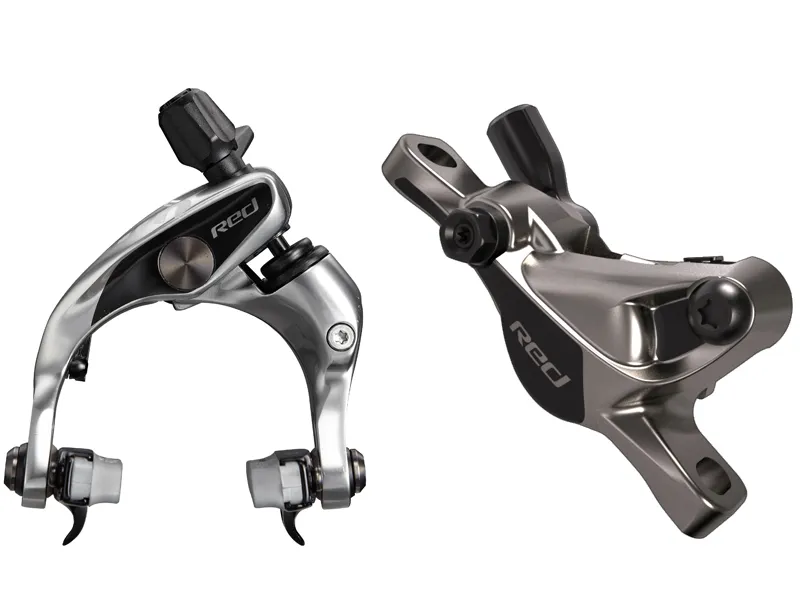What is a hydraulic road brake? How well do they work? And how much do they weigh?
A number of questions surround hydraulic road brakes in general and SRAM’s new models in particular. Here, BikeRadar answers many of them along with Paul Kantor, SRAM’s category manager for Avid brakes.
Kantor led the Avid and SRAM teams on the new Red 22 Hydro R rim and disc brakes. After a few years of testing and development, he stressed that modulation, ease of use, and dependable power in all conditions were the main targets for SRAM’s new systems, not raw power. In fact, Kantor said, too much power on a road bike is a bad thing, as braking depends on the traction of your tires; having a super-strong brake that easily locked up your wheels would certainly not improve your riding experience.
What is a hydraulic road brake?
Unlike a mechanical brake that uses the pulling force of a cable to constrict a caliper around either a rim or a disc, a hydraulic system uses the pushing force of oil to do so. The technology has been firmly embraced on mountain bikes — not to mention automobiles — for many years.
So, what’s the point of hydraulic road brakes?
In a word, modulation.
“We want to take a lot of speed off without locking up the wheel,” Kantor said. “That’s the art of braking. It’s easy to apply enough power to lock up a wheel, but that’s not the point.”

Red Hydro R rim brake and disc caliper
How much do hydraulic road brakes weigh?
SRAM Red 22 has two hydraulic brake options: rim and disc. The Hydro R rim brake works on standard wheels and frames, and weighs about 104g more than a mechanical Red 22 system. The Hydro R disc option adds about 463g (1.02lb) over a bike with mechanical Red 22, not including whatever modifications are required on the frame, fork, and wheelset for them to work.
How strong are hydraulic road brakes?
Kantor said the total power of the brakes is “not that different” than the company’s BB7 mechanical disc brakes. SRAM went back and forth on how much power to give the hydraulic systems, fully aware that some riders might expect a “wow” experience when testing them casually outside a bike shop.
“This is not built for the parking lot experience,” Kantor said. “Part of me wants people to have that experience — being able to do a nose-wheelie stop — but that is not the point.”
How well do hydraulic road brakes handle heat?
In SRAM’s case, there are two distinct heat situations for rim or disc heat, depending on which system is being used. Severe overheating of either can lead to failure, and SRAM contends that both systems stay well inside a safe zone.
For the road discs, Kantor and other SRAM engineers experimented heavily with braking load using a variety of piston lengths, pad compounds and rotor sizes. For one test, SRAM’s Chuck Dunlap descended the Stevio in Italy wearing a weighted vest, which brought rider-and-bike weight up to 250 pounds (113kg). Heat on the rotors and pressure on the brake lines were measured in real time throughout. For another test, they descended Pikes Peak in Colorado. All this data was then taken into the lab in Colorado Springs where they could replicate the forces mechanically.
“The max temperatures weren’t hotter than mountain biking,” Kantor said. “When using 140mm rotors with aluminum-backed pads, we did get some friction fade at very rapid decelerations. So, we changed to full stainless steel pads with a tweaked organic pad, and this made for much smoother braking, but also a system that was able to handle friction fade.”
For the hydraulic rim brakes, Kantor said that SRAM’s Hydro R rim brake would not make a rim hotter. “You have increased clamping force, but the coefficient of friction is the same,” he said.
Kantor said SRAM found that clamping a rim brake at 550 watts for 5 minutes straight would cause a blowout, as the friction-induced heat added pressure inside the tire. “But we could run a disc brake for 12 minutes at 800 watts, and nothing will happen. That load is analogous to riding down the Stelvio with a 250-pound load."
How well do hydraulic road brakes work?
Well, of course SRAM is going to say they work great. And, for the most part, they do. For BikeRadar’s opinion on the performance, check out the First Ride review for the Red 22 Hydro R rim brake today, and looks for reviews of the Red 22 Hydro R disc brake and the Red 22 mechanical group on BikeRadar tomorrow.

